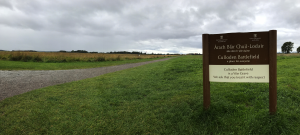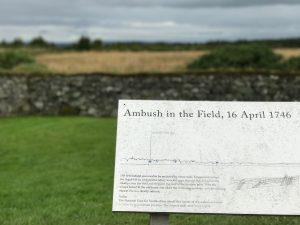 On this day in 1746, the ‘45 reached its apex as Bonnie Prince Charlie’s Jacobite army came sword to bayonet with the Duke of Cumberland’s army on that fabled foggy moor. The Battle of Culloden remains one of the most notorious and violent events in Scotland’s history. It was a dreadfully swift, breathtaking bloodbath that continues to haunt those of us with some ancestral connection to Scotland. The majority of us American-Scots have no direct connection to this infamous battle, so why is it so ingrained in us and why does it make us so emotional?
On this day in 1746, the ‘45 reached its apex as Bonnie Prince Charlie’s Jacobite army came sword to bayonet with the Duke of Cumberland’s army on that fabled foggy moor. The Battle of Culloden remains one of the most notorious and violent events in Scotland’s history. It was a dreadfully swift, breathtaking bloodbath that continues to haunt those of us with some ancestral connection to Scotland. The majority of us American-Scots have no direct connection to this infamous battle, so why is it so ingrained in us and why does it make us so emotional?
First, let’s check in with our favorite Scottish bard. The works of Robert Burns have made
mention of the 18th century struggles between the Scots and the English more times than we can count after a dram and a half of Laphroaig. “The Lovely Lass O’ Inverness” and “The Highland Widows Lament” certainly offer us Rabbie’s reflection on Culloden, but finding a Burns poem that has absolutely nothing to do with the events surrounding Culloden proves difficult.
What we find in so many Scottish poems and songs is that the significance of Culloden is at the very core, reminding us of what was lost, but also of what is so dear to us now. Burns’ works often depict a romantic wistfulness for Highland life pre-Culloden or for Charles Edward Stuart, with the Clearances always in the back of his readers’ minds as an unmentioned ominous presence. Much of what was banned as a result of the Jacobite defeat is relative to elements of Highland culture that are so critical and inspiring to us today – bagpipes, the Gaelic language, and the wearing of tartan.
 The Battle of Culloden not only changed the Scottish Highland way of life forever, but its
The Battle of Culloden not only changed the Scottish Highland way of life forever, but its
aftermath was immensely influential in the shaping of the diasporan identity and pride. Culloden is the pivotal event between what was and what was yet to come. The latter was also altered as a result of Culloden. The ‘45 Rebellion and the subsequent Clearances conjured both 19th century interest in romantic figures like the Highland Jacobite and his Bonnie Prince, as well as a supreme 21st century loyalty to bagpipes, the Scottish language, and the wearing of clan tartans.
It isn’t just the Battle of Culloden that brings to light our passion for Scotland, but the history that surrounds it. And it’s all of the traditional songs and poetry that have captured our hearts and really revived the interest in our cultural heritage.
Further Reading:
“Rare Gaelic songs to mark the Culloden commemoration”
“The Lovely Lass O’ Inverness” and “The Highland Widows Lament”


